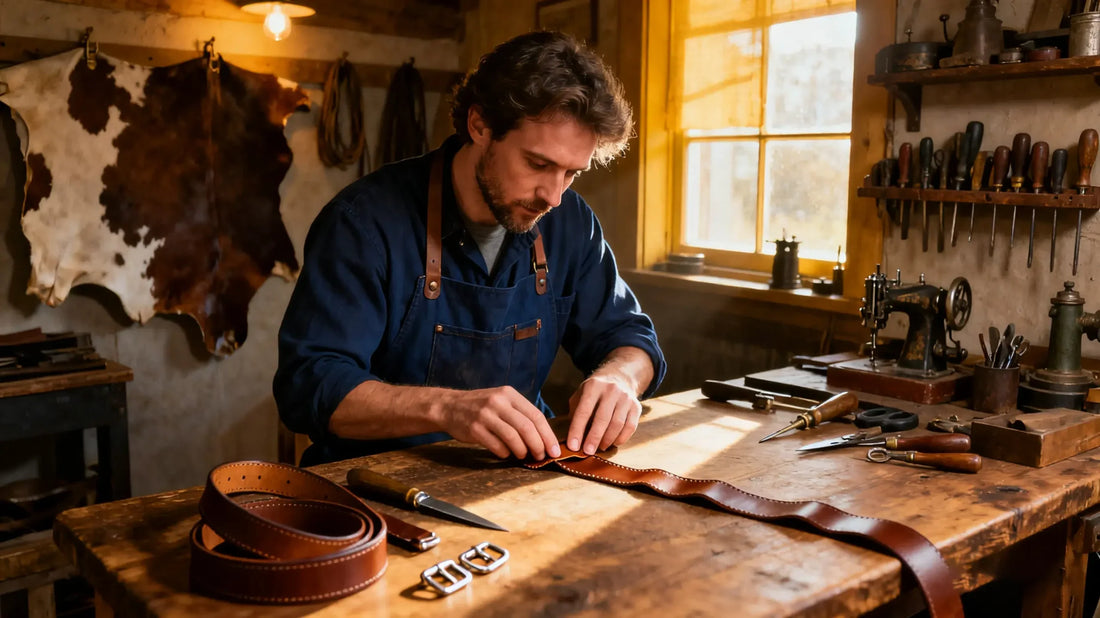
DIY Leather Craft: How to Make a Belt at Home
Share
Belts are more than just functional accessories—they’re also style statements that can transform an outfit. While most people buy them off the shelf, making your own belt at home can be an incredibly rewarding experience. Not only do you get a perfectly customized belt, but you also create something with personal meaning.
In this guide, we’ll walk you through how to make a belt from scratch, covering everything from tools and materials to step-by-step crafting techniques.
📑 Table of Contents
1.Why Make Your Own Belt?
2.Essential Tools and Materials
3.Step-by-Step Guide: How to Make a Belt
4.Belt Size Tips You Can’t Ignore
5.Styling Your Handmade Belt
6.Common Mistakes to Avoid
7.Conclusion
1. Why Make Your Own Belt?
If you’ve ever been frustrated by belts that are too long, too short, or poorly made, crafting one yourself might be the solution. Here are the main benefits:
Customization – Choose the exact width, length, and buckle style.
Durability – A handmade belt using genuine leather lasts longer than mass-produced ones.
Personal Satisfaction – Wearing something you created adds confidence.
Unique Gift Idea – A handmade belt makes a thoughtful, stylish present.
2. Essential Tools and Materials
Before you begin, gather the right materials.
Choosing the Right Leather
Select high-quality vegetable-tanned leather. A thickness of 8–10 oz (3–4 mm) works best for belts.
📌 Tip: If you’re unsure about sizing, refer to our Belt Size Chart Guide for accurate measurements.
Picking a Durable Buckle
The buckle defines the style. Options include:
Classic Frame Buckle – Best for formal leather belts.
Western Buckle – Perfect for cowboy-style outfits. See our blog Men’s Western Belt Hacks.
Modern Magnetic Buckle – A functional, futuristic alternative.
Other items you’ll need:
Cutting knife
Leather hole punch
Ruler and measuring tape
Rivets or Chicago screws
Sandpaper for edges
3. Step-by-Step Guide: How to Make a Belt
Here’s the exact process for making your own leather belt:
Step 1: Measure and Cut the Leather
Measure your waist size, then add 6–8 inches for adjustments.
Mark and cut the leather strip with a sharp utility knife.
Step 2: Punch Holes and Shape Edges
Use a hole puncher to create 5 evenly spaced holes for the buckle tongue.
Round the edges using sandpaper for a smooth finish.
Step 3: Attach the Buckle
Fold one end of the belt around the buckle’s bar.
Secure it with rivets or Chicago screws for extra strength.
Step 4: Add Finishing Touches
Apply leather conditioner to improve flexibility.
Optional: Add decorative embossing or dye the leather for a stylish effect.
4. Belt Size Tips You Can’t Ignore
One of the biggest mistakes in DIY projects is getting the size wrong. Remember:
The belt size should be 2 inches larger than your waist size.
For example, a 34-inch waist = 36-inch belt.
If unsure, check our detailed belt size chart.
5. Styling Your Handmade Belt
Now that you know how to make a belt, let’s talk about styling:
Pair a sleek black leather belt with a tuxedo (read: Do You Wear a Belt with a Tuxedo?).
A studded leather belt works with casual jeans for a bold look.
For kids, colorful children’s belts can make everyday outfits fun.
6. Common Mistakes to Avoid
Cutting leather too short – Always measure twice.
Using weak buckles – Cheap buckles can break quickly.
Skipping finishing touches – Conditioning prevents cracking.
Misaligned holes – Crooked holes ruin the look.
7. Conclusion
Making your own belt is not just a craft—it’s a statement of creativity and self-expression. With the right tools, patience, and this guide, you can easily master how to make a belt at home.
For more on belt care, check out this external guide from Leather Craft Tools by Tandy Leather.
❓ Frequently Asked Questions (FAQ)
Q1: How long does it take to make a belt?
Usually 1–2 hours, depending on experience and finishing touches.
Q2: What’s the best leather for a DIY belt?
Vegetable-tanned leather, 8–10 oz thickness, for strength and flexibility.
Q3: Can I make a belt without leather?
Yes—canvas, fabric, or paracord belts are popular alternatives.
Q4: Do I need professional tools?
No. A sharp knife, hole punch, and rivets are enough for beginners.
🚀 Call to Action
Ready to craft your first belt? Gather your tools, choose your favorite buckle, and start making your own belt today. Don’t forget to share your DIY creation with us—we’d love to see your work!
